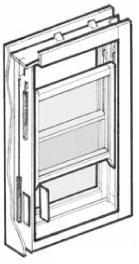06. WINDOWS
WHAT IS THE COST DIFFERENCE BETWEEN TIMBER AND ALUMINIUM WINDOWS?
Generally speaking, aluminium will be significantly cheaper only when it is either a horizontal or vertical sliding design. When aluminium is used for hinged designs e.g. casements, bi-folds, hoppers etc, there is usually little cost difference compared to timber. Timber joints are more complicated than aluminium but also far stronger, which is why timber rarely fails under cyclonic wind loads. Timber has higher finishing costs than aluminium but will generally have a longer life as aluminium, once pitted by weathering, cannot simply be sanded back and re-coated like timber. This is particularly true in locations exposed to sea spray.
ARE TIMBER WINDOWS AS WEATHER TIGHT AS ALUMINIUM AND DO THEY REQUIRE A LOT OF MAINTENANCE?
Aluminium joinery largely depends on plastic seals for its weathering capability and its life depends on how long the seals last. Just like seals on your fridge, aluminium windows will leak if the seals deteriorate. Timber joinery can be made with similar seals and in exposed positions will be equally as watertight. Woodworkers prefers to make its standard joinery without seals for normal exposure as we believe it is better not to have the hassle of intermittent seal replacement in localities where seals are not really necessary. Good timber joinery will give a lifetime of service with minimal maintenance provided it is made from materials like red cedar and kwila that have proven weathering durability. Once manufactured, the life of timber joinery is dependant on the finishes used to seal and protect it. Paint finishes have progressed markedly in the last twenty years and provided the correct finishes are chosen and used (see separate FAQ sheet) timber windows will long outlive aluminium. Timber joinery can be revived periodically, whereas powder coating will deteriorate irreparably over time and will ultimately require full window replacement. You do not expect your car to last a generation so why would you expect metal windows to be any different?
WHAT IS THE COST DIFFERENCE BETWEEN DIFFERENT TIMBER WINDOWS?
Generally speaking, double hungs (including sashless double hungs), casements and hoppers are all similar in cost and are quite economical. Sliders and louvre windows are slightly more expensive as they use more hardware and bi-folds are more expensive again for the same reason. Woodworkers carry a stock range of red cedar windows in most styles which are generally at least 20% less expensive than custom made products. Details of all stock products are given on separate product sheets and the lead times for stock solutions are usually much less than customised product. Another bargain option is the Woodworkers website for excess product - woodworkersxs.com.au which contains a constantly changing assortment of discounted stock for circumstances where size flexibility is possible. All Woodworkers windows are made using Category 1 durability sills (Kwila, Merbau) and termite resistant Durability 2 (and above) timbers elsewhere. No Durability 3 timbers e.g. Pine, Amoora etc are used.
DOES WOODWORKERS INSTALL TIMBER WINDOWS?
No. Woodworkers are purely manufacturers and not site installers. Where site installation is required we can recommend a BSA registered builder to undertake the work contracting directly with you. In most instances however, your site carpenter will be able to install the windows and separate sheets on frame fitting are available from Woodworkers that detail the process. The most essential part of any site installation is to ensure that adequate flashing is installed around the joinery to prevent water penetration. Timber joinery is not delivered with flashings intact and it is the builder's responsibility to ensure a flashing solution is installed appropriate to the exposure of the application.
IS ALL HARDWARE PROVIDED WITH TIMBER WINDOWS?
No. Where timber windows are factory framed and hung, all hanging hardware will be provided e.g. spiral balances, friction stays, rollers and tracks. The locking hardware will not be supplied or fitted unless special arrangements are made except for bi-fold units where flush drop bolts are installed as standard. This is because the locking hardware usually needs to co-ordinate with all other hardware used in the house, or, match existing. It is also preferable for the painter to fully finish all joinery before locks are installed to ensure the timber is fully sealed. Woodworkers carry a comprehensive range of different designs and finishes for window hardware, which, where possible, may need to be keyed alike for your particular application. We also carry convenient kits of hardware for most applications to ensure a complete solution is available at competitive prices. Refer to our separate FAQ sheet on hardware, together with our "Signature" hardware brochures for detailed information.
HAVE WOODWORKERS WINDOWS BEEN TESTED TO AS2047 FOR WATER PENETRATION?
Yes. All variations have been subjected to NATA wind tunnel testing and tested up to cyclonic conditions. Depending on your terrain and exposure, options are available to meet your requirements. For heavy exposure situations it is essential that our sales staff are advised accordingly so that an appropriate solution can be costed and designed. In general, weather seals are required to achieve high ratings and these can be fitted at additional cost. For most common situations in non cyclonic areas, Woodworkers avoids the use of seals as they are prone to deterioration and require periodic replacement. Seals make the painting process more difficult and are rarely required in suburban situations. Certain design of windows e.g. bi-folds, sashless double hungs and some louvres have high resistance to water penetration, whereas others such as casements or sliders require special adaptations in exposed situations. Timber windows generally have much greater structural strength against cyclonic wind loads than most domestic aluminium alternatives.
ARE TIMBER WINDOWS SUITABLE FOR BUSH FIRE AREAS?
Yes. If you are building in a designated bushfire area you will need to comply with certain specific requirements regarding windows & doors. The timber used will either need to be naturally fire retardant e.g. N.G. Rosewood or painted with an approved fire retardant such as FF88 and certified accordingly. You will be required to have aluminium, bronze or stainless steel mesh flyscreens rather than nylon screens on all external openings to restrict airborne embers from penetrating the house. There may also be requirements that toughened glass be used. Woodworkers can build windows compliant with bushfire codes provided they are advised of the bushfire rating during the ordering process and costed accordingly. 'Off the shelf' windows can be adapted for bushfire zones but may not be suitable in their standard form.
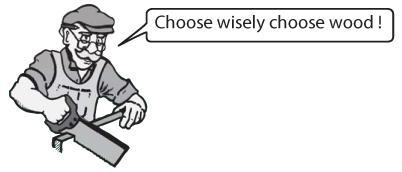
WHAT ARE THE ADVANTAGES & DISADVANTAGES OF DIFFERENT STYLES OF WINDOWS?
Virtually any style of window can be made in timber but which is best for you? The main issues are cost, ventilation, security, insect screening, size restrictions, cleaning, painting, weathering, maintenance and ability to accept privacy shutters or curtains.
DOUBLE HUNG WINDOWS
Double hungs are probably the most popular timber windows because they have a good weatherproof design, do not project inside or outside the wall and are easier to outfit with security, insect screening and privacy solutions.
| Cost | Economical when conventional mechanical balances are used |
| Variations | Traditional rope & pulley windows have greater size capabilities but are usually more than double the cost due to their complex manufacture. They operate superbly long term when manufactured correctly but are generally reserved for heritage work or architectural specialty work. Sashless double hungs operate by balancing two frameless sheets of glass top & bottom over a central pulley so that their equal weight counter balances each other. They create an obstruction free view that is remarkably watertight and low maintenance. They are similar in cost to conventional sash double hungs & can be built into doors as well as window frames. |
| Ventilation | Only half of the window is openable. |
| Security | Easy to fit security screens, although they should be hinged to permit cleaning and escape. |
| Insect Screening | Easy to screen with magnetic or retractable screens but fixed screens need to be removable to permit cleaning of the glass. |
| Size Restrictions | Generally 2100 high x 1200 wide on mechanical balances. Sashless window extremes 3000 high x 1200 wide or larger depending on window loads. Rope & pulley windows can be 3600 high x 1500 wide or larger. |
| Cleaning | Must have access to both inside and outside. |
| Painting | Requires sashes to be removed and refitted generally. Avoid acrylic paints. |
| Weathering | Very good. General manufacture permits weathering to N2. This can be increased in cyclonic areas by using seals. |
| Maintenance | Mechanical balances are warranted by manufacturer for 5 years. Replacement of broken balances after this time is relatively simple. |
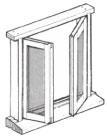
Casements permit the directional streaming of available breezes and are simple to operate. They project beyond the outside wall and can be a hazard to pedestrian traffic when used at ground level or on decks.
| Cost | Economical |
| Variations | Can be automated or manually controlled with chain winders. |
| Ventilation | Entire window space is openable to catch prevailing breezes. |
| Security | Can be fitted to inside only. |
| Insect Screening | Magnetic or retractable screens internal only. |
| Size Restrictions | Generally 1200 x 600 per sash but can be scaled up to 1800 x 800 with special heavy duty friction stays. |
| Cleaning | Can clean inside and outside from inside the building. |
| Painting | Easy to paint |
| Weathering | Only completely waterproof when a mullion is fitted between each sash. Where pairs or large groupings of sashes are rebated over each other, their weathering capability is greatly reduced. General manufacture permits weathering to N2. |
| Maintenance | Woodworkers use adjustable stainless steel friction stays that operate easily and are maintenance free. |
Traditionally an awning window was top hung open out and a hopper window was bottom hinged open in but the two terms are now both used jointly for top hinged open out windows.

hopper window

gas strut window
| Cost | Economical |
| Variations | Can be mechanical with chain winders or fitted with gas strut cylinders to provide 'hatchback' style windows. |
| Ventilation | Entire window space is openable |
| Security | Can be fitted to inside only. |
| Insect Screening | Magnetic or retractable screens internal only. |
| Size Restrictions | Usually 600 high x 1200 wide on conventional friction stays. Gas strut windows can be scaled up to 900 high x 2000 wide or larger if required, although the risk ofbowing in the open position is greatly increased. Can be grouped in vertical and horizontal banks to ventilate larger areas. |
| Cleaning | Conventional friction stay awnings can be cleaned both inside and out from inside building. Gas struts require external access for cleaning. |
| Painting | Easy to paint |
| Weathering | Similar to casements. Banks of awning windows can leak lightly on the rebate joins. For exposed positions, a separate frame for each awning window is recommended or seals installed. |
| Maintenance | Woodworkers use adjustable stainless steel friction stays that operate easily and are maintenance free. |
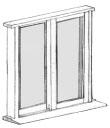
2 sash
sliding windows
Horizontal sliding windows have similar characteristics to vertical double hung sliding windows but are not as secure or economical. Woodworkers sliders feature brass track top & bottom and all rollers are adjustable stainless steel, making them the best available.
| Cost | Mid range |
| Variations | Sliding windows can be top hung on overhead track or slide on bottom rollers. As load transfer is more direct with bottom rollers and maintenance is simpler this is our preferred construction. Top hung sliders can operate like a conventional slider or can be face of wall sliding which permits full width openability providing the potential security and weathering drawbacks can be overcome. |
| Ventilation | Only a portion of window space is openable. |
| Security | Sliding sashes can be levered off the bottom tracks if not adjusted snug in the frame. They are therefore not ideal for security situations. |
| Insect Screening | Magnetic, retractable screens and fixed screens all possible. |
| Size Restrictions | Very large sizes up to 3m high and 6m wide possible. |
| Cleaning | Access to both sides required for cleaning. |
| Painting | Rolling sashes can be removed for painting. |
| Weathering | Water penetration can occur under sashes in high winds unless bottom seals are installed. The standard for timber joinery is for the sliding sash to run externally so that it can drain cleanly if opened while wet. For security reasons however, most people use inside sliding sashes which will trap water internally if opened in the wet. Sliders are not recommended for high wind locations. General manufacture permits weathering to N2. |
| Maintenance | Woodworkers use adjustable stainless steel rollers and brass tracks to allow easy maintenance. |

2 sash
bifold window
Horizontal sliding windows have similar characteristics to vertical double hung sliding windows but are not as secure or economical. Woodworkers sliders feature brass track top & bottom and all rollers are adjustable stainless steel, making them the best available.
| Cost | High end. |
| Variations | For large openings a bottom track is required and door bi-fold hardware can be used. |
| Ventilation | Entire window space is openable. |
| Security | Difficult to fit security screens. |
| Insect Screening | Retractable screens recommended. |
| Size Restrictions | Maximum 3 sashes in each direction (can be scaled up for larger openings by using door rather than window hardware). Maximim size 1500 x 3680 for 3 each way without a bottom track. |
| Cleaning | Access to both sides of window required for cleaning. |
| Painting | Easy to paint |
| Weathering | Open out bi-fold windows are fully tested to be weather tight to N2. Open in bi-folds are not weather tight. |
| Maintenance | Occasional track cleaning and adjustment may be required. |
LOUVRE WINDOWS
Louvre windows are generally expensive and have a number of inherent safety, security and screening issues but are popular for architectural situations where fully adjustable ventilation is required.

glass louvres

timber louvres

jalousie louvres
| Cost | Mid to high range |
| Variations | General louvre systems accommodate either 102mm or 152mm glass or timber blades. Jalousie Louvre systems operate on a rear cantilever blade rather than central pivot and provide integral security as well as full ventilation. Louvre windows can be operated by manual or motorized systems for inaccessible positions. |
| Ventilation | Entire window space is openable. |
| Security | Not generally secure, except for Jalousie designs. Can have security bars separately fitted to galleries but should not be used in high risk areas. |
| Insect Screening | Can have fixed screens fitted externally if louvres are positioned to inside face. The choice in screening will determine the construction of the window and therefore needs early consideration and choice. |
| Size Restrictions | The maximum louvre width is 900mm for 152mm blades and 750mm for 102mm blades (excluding frame) depending on your geographical position and window loads. |
| Cleaning | Can be cleaned for one side only |
| Painting | Powder coat or anodized galleries limit finishing requirements |
| Weathering | Fully tested. Weather tight to N2 |
| Maintenance | Minimal except sea spray positions where corrosion of the galleries can occur. |
WHAT TYPE OF GLASS DO YOU USE IN WINDOWS?
All glass used in both windows and doors needs to comply with the Australian Standard AS1288-2006 if your building is to pass the certification process. In windows this standard requires that glass deemed to be in a 'human impact' area needs to be safety glass depending on its size and position (particularly for bathrooms, rooms with a spa, stairwells, items 600mm off the floor and full height items. For further clarification see our separate FAQ sheet on timber + glass or consult with our sales staff. There are issues in matching most of the heritage obscure and coloured glasses commonly found in restoration work as most of these glasses, if still available, are usually 3mm thick and therefore not acceptable under the current codes. Ask our sales staff if the glass you propose will be compliant in any particular situation, as the onus is on the buyer to correctly advise the supplier if glass is to be installed in any locality where building code restrictions could apply.
WHICH GLASS OPTIONS ARE AVAILABLE?
Clear Glass
For most general work 4mm clear annealed glass is used. Size restrictions apply to the use of 4mm annealed glass depending on the wind rating of your property e.g. for suburban areas N2/W33 max size is just under 2m². For safety glass 4mm toughened or 6.38mm laminated glass is used. For louvre windows requiring safety glass 6mm toughened is used.
Tinted Glass
There are inexpensive generic tinted glasses called Austints which come in Bronze, Grey and Green in both laminated and normal sheet glass form. There are also more expensive proprietary tints in Arctic Blue, Evergreen and Super Grey, the latter usually requiring toughening to give it stability. Tinted glasses in general do not give significant thermal protection but they do provide some UV protection and aesthetically colour the outlook from inside.
Performance Tints
There is a range of performance tints that have significant thermal properties by limiting the amount of heat that passes through the glass that also generally block up to 99% of UV radiation. Generally they achieve this through a surface coating which, although very tough, needs to be handled with care a little more than other glass types. These glasses are much more expensive than normal tints.
Translucent
Glass can be made obscure by surface treatment such as sandblasting, acid etching or printing, or by laminating clear sheets with a translucent silicone core. Sandblasting leaves the surface rough and makes cleaning difficult unless oversprayed with a clear protective finish. Laminated translucent gives a modern look and comes in partly translucent forms such as soft white or shoji (a rice paper glass) or full block out white translucent.
Obscure & Patterned Glass
There is a very wide range of patterned glasses which obstruct the transparency of clear glass. The minimum thickness of the glass anywhere in its pattern is taken as the thickness for purposes of compliance with the Glass Code. As a consequence, many obscure glasses are no longer compliant with current regulations as most are deemed to be only 3mm or less. Cold laminating processes exist to beef these glasses up to compliance thicknesses but the cost is high and the maximum size is very restricted.
Reflective Glass
Reflective glass rebounds the sun's rays and thereby limits heat intrusion. At night the process is reversed and the glass becomes a mirror to the inside which can be disconcerting. Permanent one-way mirror products e.g Mirror pane for special applications are also available.
Coloured Glass
There is a large range of special coloured lead lighting glass available in 3mm thickness which can be used in small areas (up to 0.1m2) for accents, depending on the position. They can be cold laminated at great expense for wider architectural use if necessary. Woodworkers only carry the arctic range of blue, amber, wine and green as standard. All other colours and patterns of coloured glass will have the additional cost of having to purchase a full sheet of each glass type added to the joinery cost.
Self Cleaning
Yes - self cleaning glass does exist and uses a special surface film to repel dust etc. Its cost is somewhat prohibitive at about $300 per sq m. It may be useful for inaccessible applications where maintenance is broadly impracticable but note that it only works if it is exposed to regular rainwater.
WHICH SAFETY GLASS DO YOU USE?
Safety glass can either be tempered glass (which breaks into harmless glass confetti) or laminated glass (which does not disintegrate when broken). Laminated glass usually comprises two layers of 3mm glass sandwiching a central silicone core which binds the panel together. It is usually 6.38mm thick but much greater thicknesses are possible for acoustic situations. It is used for most modern car windscreens and though relatively simple to break has the advantage that the panel remains intact after breaking due to the cohesiveness of the silicone core. Laminated glass significantly reduces sound penetration and can be easily cut and is therefore used by Woodworkers for most general fabrication work. Tempered glass, also known as toughened glass, is a process of reheating and cooling standard glass to make it more flexible and harder to break. It has approximately 4 to 5 times greater breaking strength than standard glass but cannot be cut or machined after toughening. It is easier to scratch than normal glass but is much lighter than laminated glass. Woodworkers use toughened glass in many of their stock doors but do not use it for general joinery fabrication work.
DOES WOODWORKERS USE PUTTY OR BEADS TO FIX THE GLASS?
Both. Traditionally linseed oil putty was used for glazing external joinery in either white or brown tint. Putty is extremely weathertight but has the disadvantage that it will commonly take 10 to 15 weeks to become firm and it is prone to site damage through incorrect handling. It cannot be used with acrylic paints and is very attractive (while soft) to birds and animals for its oil content. It requires several days to 'set' before it can be transported and may sag in hot weather. As a consequence of all these disadvantages (and the invention of glazing silicones in the recent past) timber beads are now preferred for most external glazing. Timber beads are easier to remove to replace glass and are durable and aesthetically more attractive. Timber glazing beads are always on the outside face of the joinery and should be clear or paint finished so that the coating runs approximately 1mm onto the glass all round. Woodworkers will glaze custom joinery with putty or beads at the same cost except for curved work where putty glazing is substantially less expensive. Putty is used as standard for all curved work unless otherwise agreed as curved timber beads are both dangerous and expensive to produce.
WHAT IS THE WARRANTY ON DOUBLE HUNG SPIRAL BALANCES?
Woodworkers uses Whitco Spiral Balances which are warranted by their parent Assa-Abloy Australia Pty Ltd in accordance with Australian consumer law. If spiral balances become inoperative the onus to repair or replace them rests firstly with the hardware manufacturer. If it is faulty, it is the manufacturer that warranties it, not the department store. Assa Abloy warrants its Whitco branded products to be defect free in material and workmanship including mechanical parts for 10 years from the date of purchase by Woodworkers, subject to limitation and exclusions set out in their warranty (a copy can be viewed on their website Warranties and Guarantees).
Faulty/broken claims can be made by contacting Assa Abloy direct on
https://www.assaabloyopeningsolutions.com.au/en/contact/
Ph: 1300 LOCK UP(1300 562 587), Outside Australia: +61 3 8574 3619
Whitco spiral balances are pre-fitted to manufacturers specification according to the size and weight of each sash under factory conditions. Removal of the sash and balances on site for painting or in some cases re-glazing and then the refitting of this product by inexperienced installers is a major cause of failure due to over or under tensioning. If you feel the product has a legitimate defect, Assa Abloy will repair the problem but will invoice the work if the cause isn't covered by their warranty. Woodworkers retains responsibility to ensure the warranty claim is fairly assessed.
The Woodworkers Company sell replacement spiral balances and have a video on their website explaining the process of removing and replacing spirals but do not undertake site repair work unless defects are advised at the time of delivery. We also have independent contractors that undertake this kind of work, which you pay directly to undertake replacement or retensioning work, where replacement isn’t a warranty claim.
CAN I HAVE A WINDOW OVER MY COOKTOP?
During the design process this should be cautiously considered as there are a number of drawbacks. Different appliance manufacturers may have different guidelines regarding the placement of windows near stovetops. Gas burners get particular attention due to the naked flame heat source. Generally the cook-top should be at least 200-300mm horizontally from any combustible material, and gas cook-tops require 500-600mm of clearance vertically. Remember to include your architraves (if any) when considering your window placement. The glass preference is for toughened glass because it is heat tolerant, but be aware that toughened glass is more easily scratched than ordinary float or laminate glass and therefore additional care would be essential when cleaning. Given the nature of oily grime build-up likely in a cook-top window, the cleaning process will be at once more delicate and more arduous. Avoid low-E glass as the pyrolitic coating may be compromised during heavy cleaning. If the window is operable (rather than fixed) it may have an impact on the effectiveness of exhaust fans and the advantage of ventilation can be lost if gas burners self extinguish.
OPENING RESTRAINTS ON WINDOWS
The National Construction Code was amended from 1 May 2013 to require new buildings to be fitted with window opening restraints in bedrooms of residential buildings and early childhood centres. The requirement applies when the potential fall exceeds 2 metres and does not apply where the window is positioned 1.7 metres or higher above the internal floor. Windows affected must be restricted from opening with a mechanical restraint or screen so that a 125mm diameter sphere cannot pass through at any point. The restraint needs to have a child resistant release mechanism (e.g. a key lock) which can enable the device or screen to be removed, unlocked or overridden so, for example, the window can be cleaned. Woodworkers can advise on suitable options for window restraints but the final acceptability is at the discretion of the certifier.
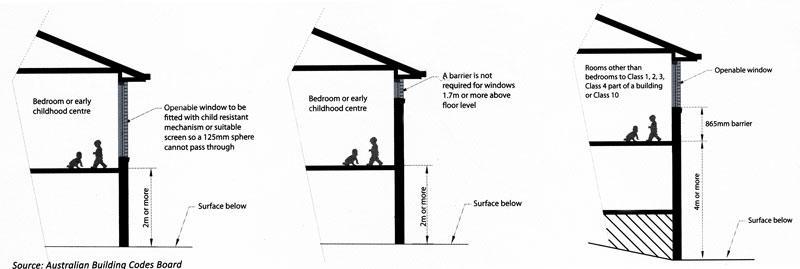
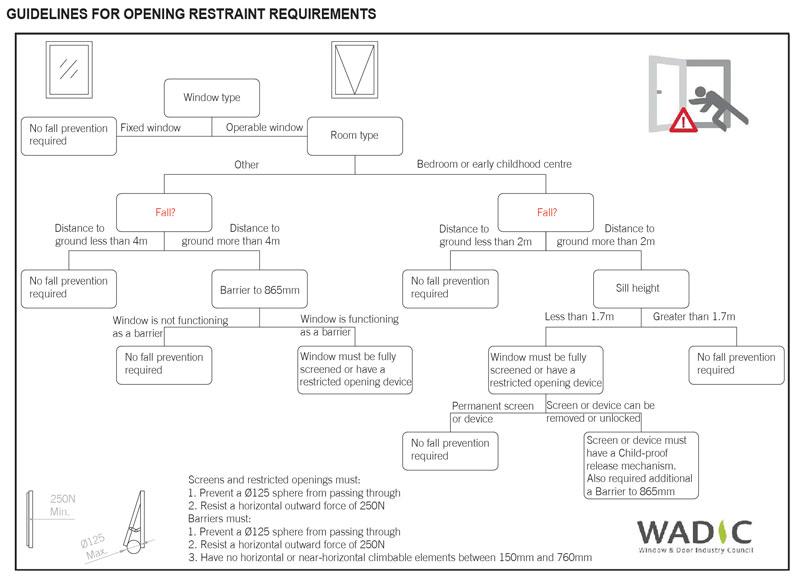
SEE BELOW CASE STUDIES PROVIDED BY THE AUSTRALIAN WINDOW ASSOCIATION FOR MORE INTERPRETATION OF THIS LEGISLATION.
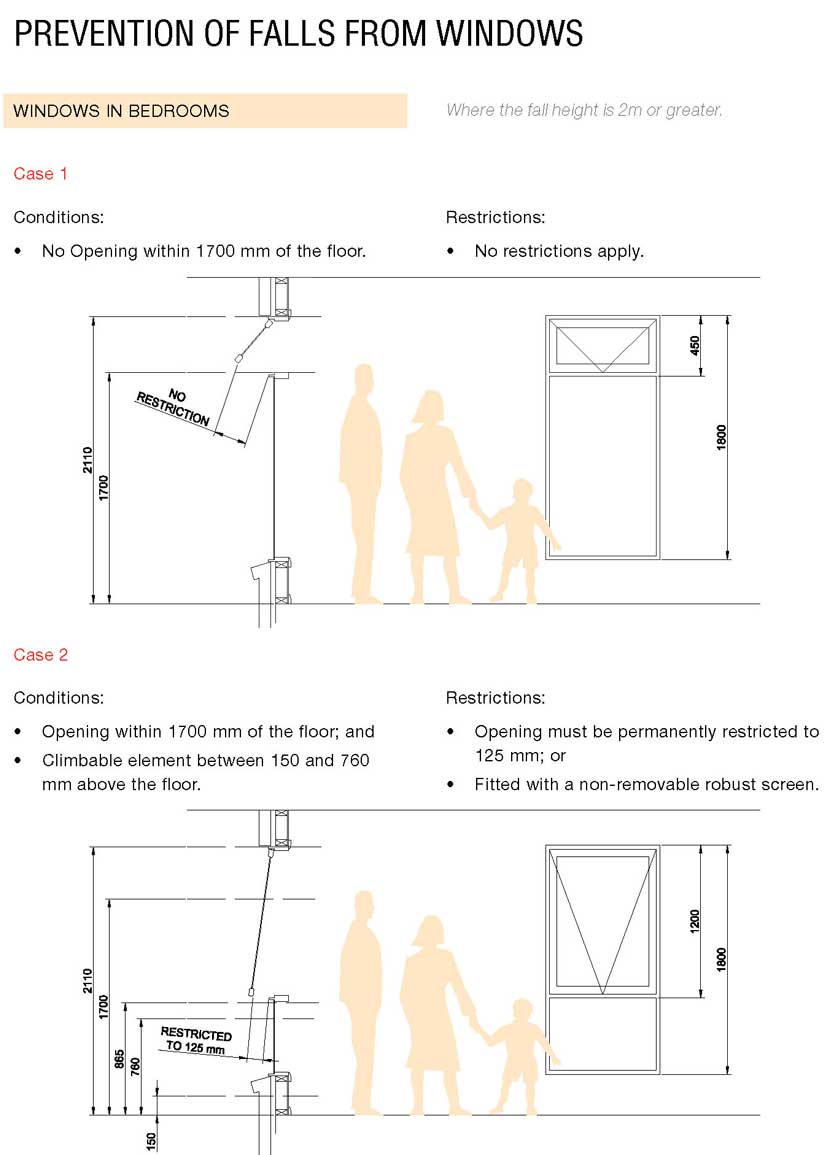
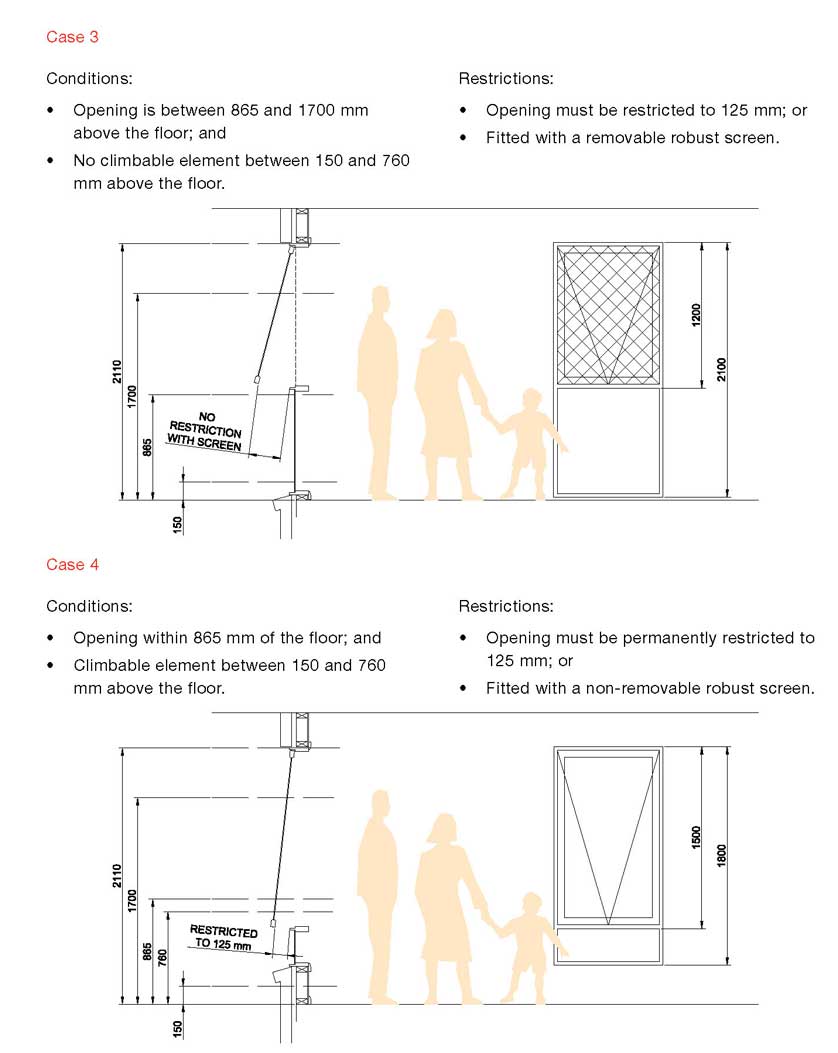
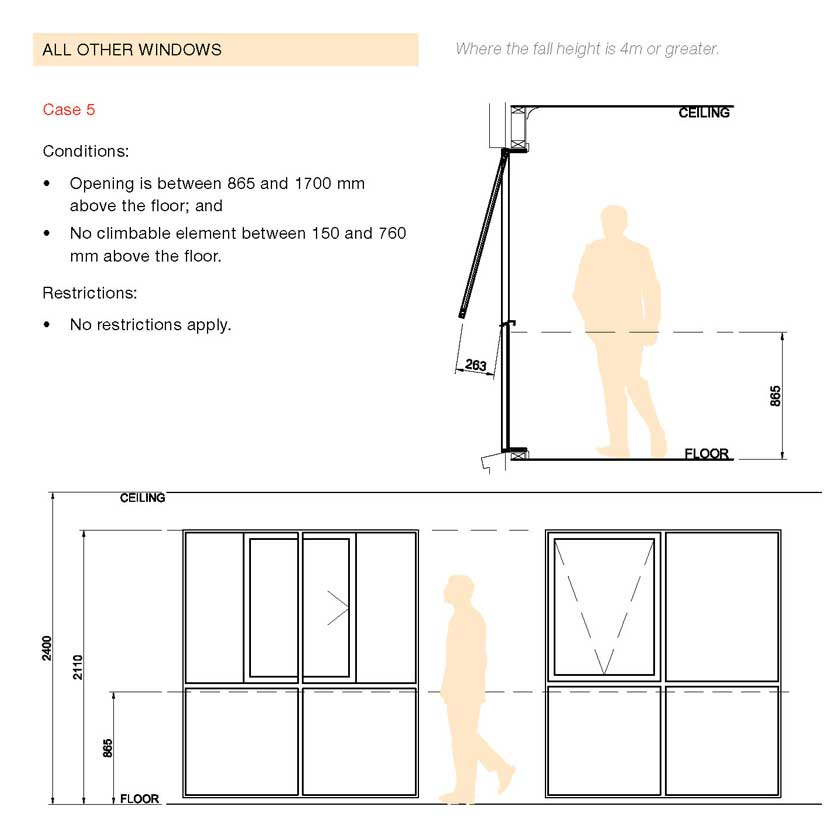
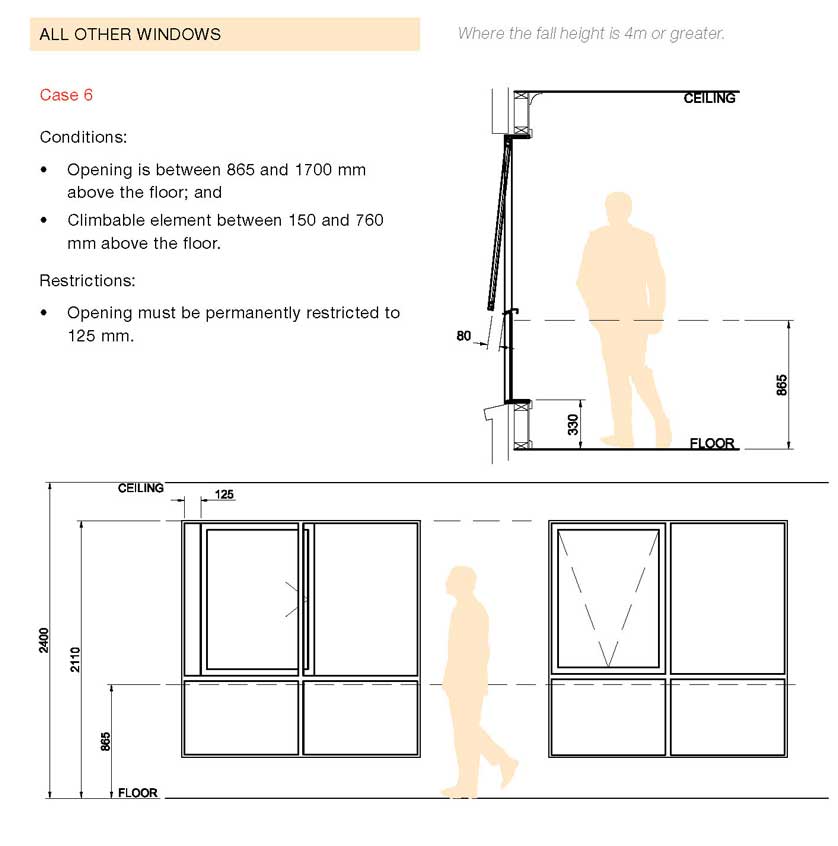
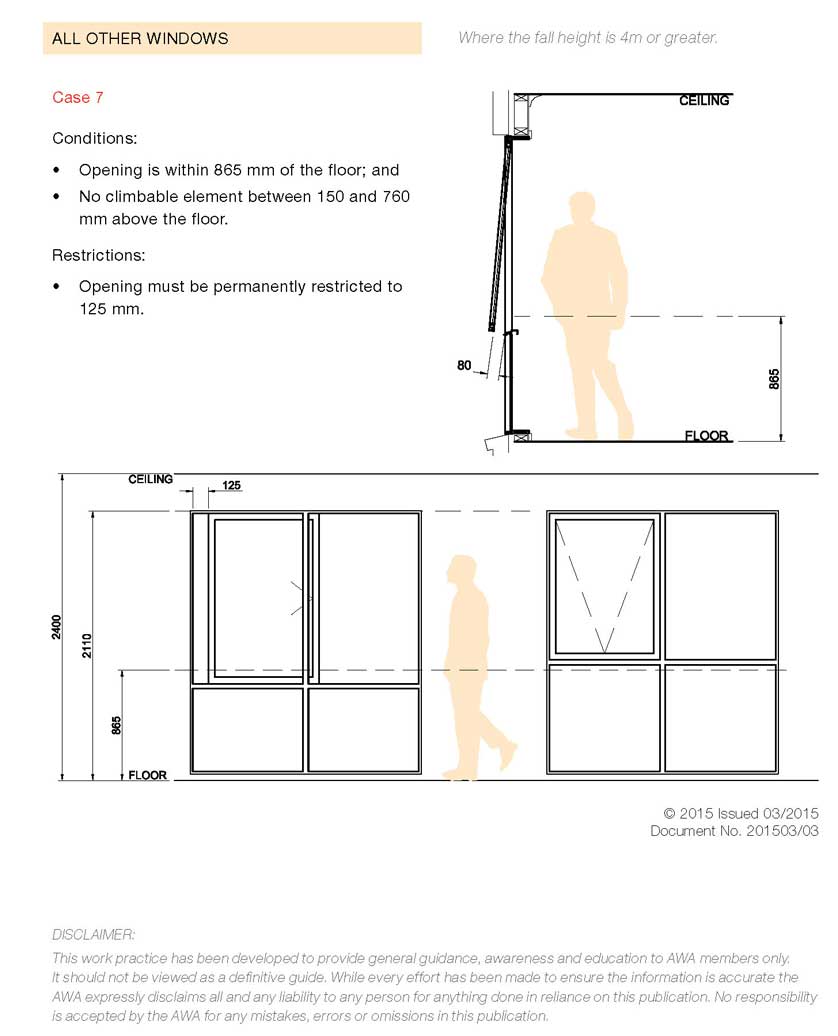
 My Account
My Account My Wishlist
My Wishlist My Enquiries
My Enquiries